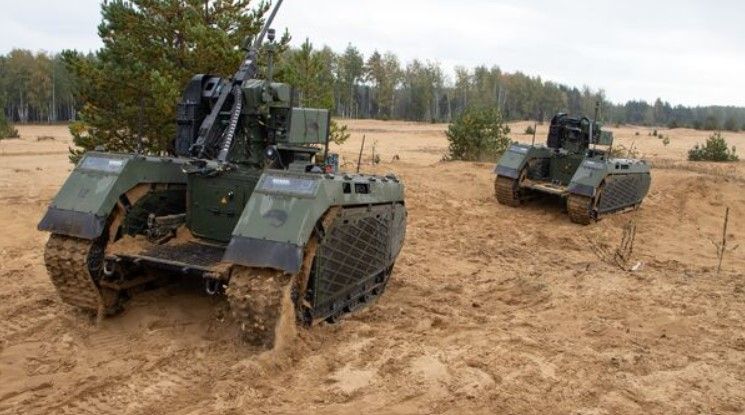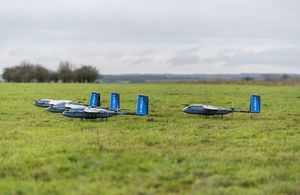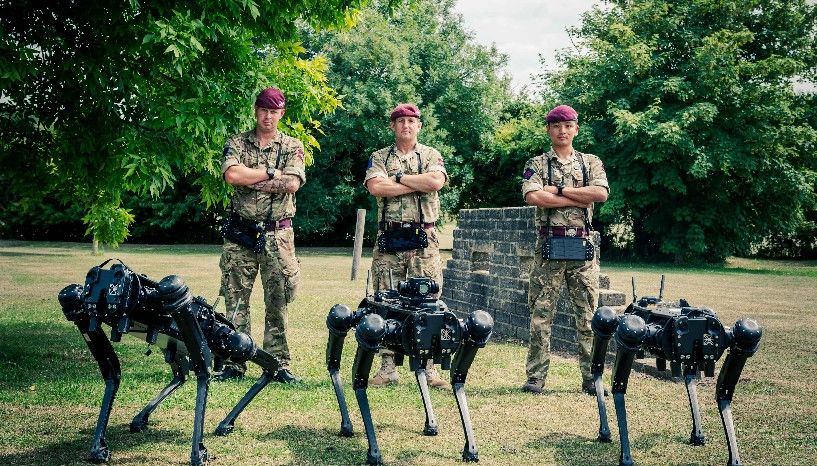Military Robotics to be worth $25 billion by 2028
)
The global market in military Robotics is set to reach new heights in the next five years, as its valuation has gone from $13.9 billion in 2021 to a projected $25.7 billion in 2028, at a compound annual growth rate of 10% (2022-2028). Defence Engage looks at how some of its members are pioneering underwater robotics and robot navigation technologies in combination with AI and other emerging tech.
As an emerging technology with a variety of applications, robotics has huge potential to change the nature of frontline conflict whether on land or sea. The primary uses of robots in defence are: explosive ordnance disposal (EOD), swarm tactics, last-mile resupply, load carriers, exoskeletons plus undersea navigation and surveillance. Several nations are spending on robotics with a view to assist or even replace humans on the frontline to reduce risk, help rapid deployment or strengthen sustainment for example. The advantages of robotics are motivating development and investment, though achieving trusted autonomy will be essential for further growth.
Robotics in defence strategy & policy
Australia unveiled its robotics strategy in August 2022, setting out its aim to enhance its battlefield capabilities. The vision outlines a desire for a reduction in battlefield risk, better decision-making and troop protection, alongside more efficient logistical and supply functions. According to Australia’s RICO (Robotic & Autonomous Systems Implementation and Coordination Office), their objectives outlined in the 2022 strategy are designed to implement the Army’s Robotic and Autonomous Systems (RAS) Strategy to gain asymmetric advantage in future warfare. They predict that the successful adoption of robotics technology will bring significant benefits to front-line users:
The UK’s Robotics and Autonomous Systems (RAS) capability is designed to exploit advancements in science and technology, through an ethical adoption policy and in aid of the MOD’s wider strategic frameworks. When combining advanced robotics with AI for example, there is policy in place to deliver trusted solutions which add value and take pressure off of front-line users. UK science and technology accelerator Dstl has the following capabilities to maintain in relation to Robotics, AI and the combination of remote and autonomous systems:
- Design, integration and interfaces
- Consent, trust and confidence: assured autonomous systems that match our ethics and are not inadvertently harmful
- Verification, validation and vulnerabilities – designing and testing systems to ensure they are behaving as intended and not open to attack
- Human-machine teaming
- Threat assessment
Canada’s ‘Innovation for Defence Excellence and Security (IDEaS)’ hosts “Robot Round-up” which calls upon innovators to provide and demonstrate advancements in robotics platforms and how they can aid in high-risk tasks. The initiative gives innovators a chance to pitch their robotics solutions to military experts, with the ability to compete for prizes and development programs. The main aim is to ‘include advancements in mobility, manipulation, sensing, localization of threats, advanced modelling, information synthesis, or by using Artificial Intelligence (AI), Machine Learning (ML), supervised autonomy, techniques to reduce the operator involvement in the task’ (Canadian Government’s IDEaS).
South Korea has been developing robots for defence, including one which “can explore underground tunnels without topographic information, detecting risks and generating a 3D map of the exploration area… It can also receive modifications to perform different missions, and it is equipped with artificial intelligence-based software for recognition, judgement and exploration functions. This is another example of how robots are set to take pressures off of front-line users, as ‘a single operator can control the robot remotely with a mobile phone or tablet, allowing the user to wield multiple systems at once’.
Elsewhere, the US and Japan appear near to an agreement regarding the use of dual-use (civilian and military) technologies, including robotics. Robotics is being pitched, alongside AI, Quantum Computing and Drones as a key area of competition with China. With record budgets in the US and Japan looking to bolster defence in the current upward trend of strategic collaboration, investments in Robotics and other emerging technologies may provide a strategic edge.
Testing and operating robots in the field
Back in 2022, the Royal Netherlands Army conducted armed robot trials in a first amongst western militaries. According to Janes, four of the Armed THeMIS UGVs (unmanned ground vehicles) were deployed to Lithuania, carrying .50 cal machine guns. The units themselves are an Estonian design, with Australian weapons stations.

Recent advancements have prompted a string of allied collaborations in the use and sharing of emerging technological advances. According to a UK government press release, in November 2022, a team of 30 AI and autonomy experts from the UK and US deployed as a joint AI Taskforce to the Project Convergence 22 (PC22) experiment held at the US National Training Centre. A part of this AI taskforce project was the advancement of military robotics, where the technology is being harnessed to inform the Joint Warfighting Concept and provide meaningful battlefield assets to Joint All Domain Command and Control.

Testing robotics and human interaction, DE&S partnered with British Army to test Ghost V60 Robotic Dogs capabilities and utility in conjunction with soldiers from the 23 Parachute Engineer Regiment. According to DE&S, the unit can carry modular add-ons, including cameras, sensors, LIDAR, and other loads. One of the main advantages of such a system is the ability to deploy a unit into a hazardous area, reducing the threat to human operators.

Motivating these innovations, agreements and partnerships is the looming threat of being out-innovated by adversaries. Chinese investment in Robotics is set to soar, with Beijing laying out its long-term plan for military and civilian robotics designed to transform its manufacturing capabilities. Alongside its manufacturing impact, robotics is being actively considered in military terms. In the last year China began delivery of its ‘mechanical Yak’, a multi-environment quad-legged robot, said to be fast, strong and large, capable of deploying different loads and modules.
Who is spearheading robotics innovation?
Many companies across the global defence industry have looked to Robotics as a way of giving frontline-users a new strategic edge. Several primes including Raytheon, Northrop Grumman, Leidos, Lockheed Martin, Elbit Systems and Rheinmetall are amongst the main producers of robots for military use.
Prominent names in industry include Boston Dynamics and Ghost Robotics. Boston Dynamics have made waves with their dog-like Spot Inspection Solution, Stretch Warehouse Solutions and ‘the world’s most advanced humanoid robot’, called ‘Atlas’. Meanwhile, Ghost Robotics has been pitching a variety of solutions, which they see as able to dynamically handle various environments. The demands upon robotics solutions are huge, but these capabilities allow them to be major assets on the battlefield. Ghost Robotics has high expectations for its solutions, citing a need to carry sensors, mesh communications, and manipulators for a range of data collection, intelligence, security, asset protection, and military-specific uses where the operating conditions can be hard for even humans to operate in.
Underwater robotics and robotics in navigation
A common use of robotics in in undersea technology. Several Defence Engage members are pushing the boundaries of robotics innovation at sea, such as Kraken Robotics Inc. who are pioneering robotics innovations with a variety of sea-based products, each employing impressive industry-leading technology. The applications of their robots vary from AI, Sensory Mapping tech (seen in their 3D Laser-Imaging Service), launch and recovery systems for offshore surveys (ALARS), and their variety of AUVs, capable of sonar mapping and high quality seabed imagery. Advanced Navigation also innovates with AI navigation systems and robotics to provide a vast array of underwater applications, such as: hydrography, undersea survey, Remotely Operated Vehicle (ROV) and Autonomous Underwater Vehicle (AUV) control and navigation, reef and habitat monitoring, research, and inspection of critical infrastructure.
Taking a different approach, underwater acoustics and robotics are utilised by RTSYS alongside their other engineering poles of Software, Acoustic Signal Processing and Embedded Electronics. RTSYS is spearheading their French-made solutions, comprised of innovations in mechatronic design, hydrodynamics, weight optimisation and payload integration.
VectorNav Technologies specialises in surveillance and mapping from the deep sea to the stratosphere, with capabilities including Aerial Photogrammetry, Lidar Mapping, SATCOM integration and EO/IR Surveillance. Seemingly redefining what's possible in today's inertial navigation technology, their kit has featured on the record-breaking Airbus Perlan Mission II glider which soared to 76,000 feet, yielding insights into high-altitude aerodynamics, flight safety and Martian exploration.
All are part of the Defence Engage network, showcasing and connecting suppliers and innovative solutions. Other SMEs can join Defence Engage by applying for a free Profile, while buy-side professionals seeking the next pioneering capabilities can contact hello@defence-engage.com to access our members-only Defence Engage network.
View also:
The big 5 Defence trends for 2023
10 Innovations that made waves in 2022
DISCOVER DEFENCE ENGAGE APPLY FOR A PROFILE DEFENCE CONTRACT DIGEST FOLLOW US ON LINKEDIN

